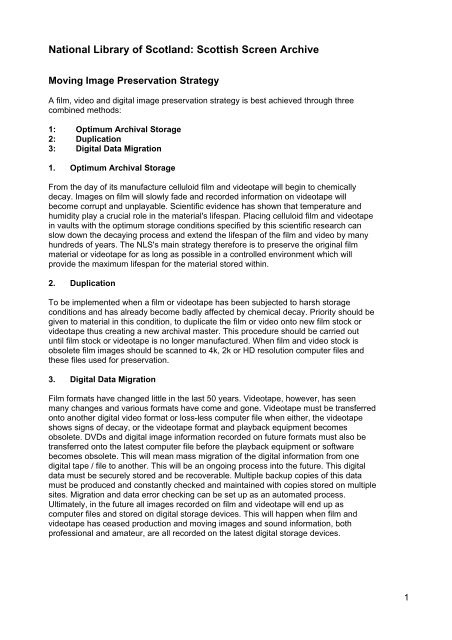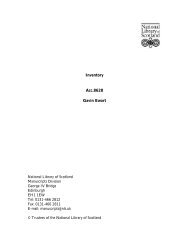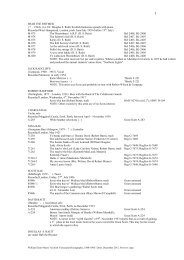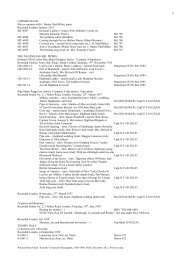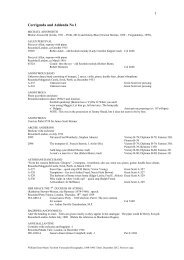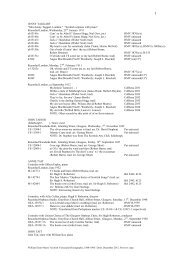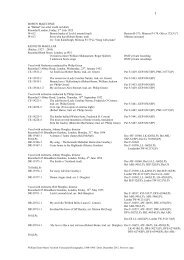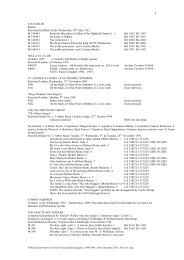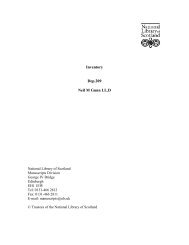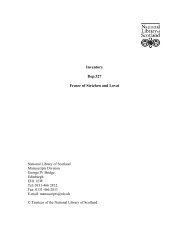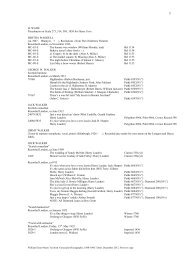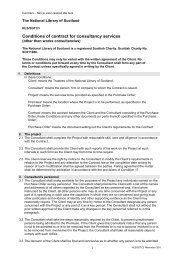Scottish Screen Archive moving image preservation strategy (PDF)
Scottish Screen Archive moving image preservation strategy (PDF)
Scottish Screen Archive moving image preservation strategy (PDF)
Create successful ePaper yourself
Turn your PDF publications into a flip-book with our unique Google optimized e-Paper software.
National Library of Scotland: <strong>Scottish</strong> <strong>Screen</strong> <strong>Archive</strong><br />
Moving Image Preservation Strategy<br />
A film, video and digital <strong>image</strong> <strong>preservation</strong> <strong>strategy</strong> is best achieved through three<br />
combined methods:<br />
1: Optimum Archival Storage<br />
2: Duplication<br />
3: Digital Data Migration<br />
1. Optimum Archival Storage<br />
From the day of its manufacture celluloid film and videotape will begin to chemically<br />
decay. Images on film will slowly fade and recorded information on videotape will<br />
become corrupt and unplayable. Scientific evidence has shown that temperature and<br />
humidity play a crucial role in the material's lifespan. Placing celluloid film and videotape<br />
in vaults with the optimum storage conditions specified by this scientific research can<br />
slow down the decaying process and extend the lifespan of the film and video by many<br />
hundreds of years. The NLS's main <strong>strategy</strong> therefore is to preserve the original film<br />
material or videotape for as long as possible in a controlled environment which will<br />
provide the maximum lifespan for the material stored within.<br />
2. Duplication<br />
To be implemented when a film or videotape has been subjected to harsh storage<br />
conditions and has already become badly affected by chemical decay. Priority should be<br />
given to material in this condition, to duplicate the film or video onto new film stock or<br />
videotape thus creating a new archival master. This procedure should be carried out<br />
until film stock or videotape is no longer manufactured. When film and video stock is<br />
obsolete film <strong>image</strong>s should be scanned to 4k, 2k or HD resolution computer files and<br />
these files used for <strong>preservation</strong>.<br />
3. Digital Data Migration<br />
Film formats have changed little in the last 50 years. Videotape, however, has seen<br />
many changes and various formats have come and gone. Videotape must be transferred<br />
onto another digital video format or loss-less computer file when either, the videotape<br />
shows signs of decay, or the videotape format and playback equipment becomes<br />
obsolete. DVDs and digital <strong>image</strong> information recorded on future formats must also be<br />
transferred onto the latest computer file before the playback equipment or software<br />
becomes obsolete. This will mean mass migration of the digital information from one<br />
digital tape / file to another. This will be an ongoing process into the future. This digital<br />
data must be securely stored and be recoverable. Multiple backup copies of this data<br />
must be produced and constantly checked and maintained with copies stored on multiple<br />
sites. Migration and data error checking can be set up as an automated process.<br />
Ultimately, in the future all <strong>image</strong>s recorded on film and videotape will end up as<br />
computer files and stored on digital storage devices. This will happen when film and<br />
videotape has ceased production and <strong>moving</strong> <strong>image</strong>s and sound information, both<br />
professional and amateur, are all recorded on the latest digital storage devices.<br />
1
A. Motion picture film <strong>preservation</strong><br />
All gauges of film stock are preserved by <strong>Scottish</strong> <strong>Screen</strong> <strong>Archive</strong>, these include:<br />
35mm, 16mm, 9.5mm, 8mm standard, Super 8mm plus other rarer gauges if required<br />
There are two routes for preserving celluloid stock:<br />
1: Storage in controlled environment<br />
2: Duplication of deteriorating originals to modern film stock<br />
These are not mutually exclusive. The size of <strong>Scottish</strong> <strong>Screen</strong> <strong>Archive</strong>'s divisional film<br />
collection requiring to be duplicated for <strong>preservation</strong> vastly exceeds the capacity of the<br />
<strong>Scottish</strong> <strong>Screen</strong> <strong>Archive</strong>'s financial and technical resources. The principal <strong>strategy</strong><br />
therefore is to preserve the film material through storage in a controlled environment,<br />
thereby stabilising the collection against further deterioration, and buying time for any<br />
duplication in the future. The small annual divisional budget for <strong>preservation</strong> duplication<br />
will be reserved for those specific classes of material under threat from chemical decay<br />
and for which long term storage is not an appropriate conservation <strong>strategy</strong>.<br />
1. Preservation through storage<br />
Storage conditions are vital in preserving celluloid motion picture materials. Cold<br />
temperatures and low relative humidity will increase the lifespan of film stock by<br />
hundreds of years. This will prevent the fading of colour dyes and fungus growth.<br />
Materials affected by acetic degradation, known as ‘vinegar syndrome,’ require to be<br />
stored at sub-zero temperatures to slow down this autocatalytic chemical reaction. The<br />
time taken for motion pictures to degrade to destruction depends on three main factors,<br />
stock type, storage conditions and processing quality. Nitrate and acetate film stock can<br />
become chemically unstable within a short period of time if stored at high temperatures<br />
and humidity. Badly processed film also speeds up chemical decay. The main NLS<br />
<strong>preservation</strong> <strong>strategy</strong> should be to aim for optimum archival storage conditions in its film<br />
vaults.<br />
Film Type<br />
Colour and Nitrate Film<br />
Black and White Film<br />
Film with Commag Soundtrack<br />
Magnetic Soundtracks<br />
Optimum Archival Storage Conditions<br />
-20 degrees centigrade / 30% relative humidity<br />
-10 degrees centigrade / 30% relative humidity<br />
10 degrees centigrade / 35% relative humidity<br />
10 degrees centigrade / 35% relative humidity<br />
New scientific research may mean that optimum storage conditions may change in the<br />
future. NLS should be prepared to modify storage conditions based on any new<br />
scientific evidence or experience gained.<br />
2
2. Preservation through duplication<br />
The following classes of film will be prioritised for duplication:<br />
Nitrate film stock: Due to the inevitable chemical breakdown, the hazardous<br />
nature of nitro-cellulose stock and the fact that NLS cannot<br />
store large quantities of material on site for safety reasons.<br />
<br />
<br />
Acetate picture or magnetic soundtrack affected by vinegar syndrome.<br />
Magnetic soundtracks must be rerecorded onto new magnetic stock or digitised.<br />
3. Digital technology<br />
Digital technology will eventually take over from motion picture film. s this technology<br />
increases its hold on <strong>moving</strong> <strong>image</strong> production and exhibition, traditional photochemical<br />
film laboratory services will decline and film duplication stocks will be phased out.<br />
Eventually motion picture film stock manufacture will cease to exist. 35mm film should<br />
be scanned at a resolution of at least 4k and 16mm film at 2k. Digital technology will<br />
eventually become a major ally in film <strong>preservation</strong>, enabling the duplication of the<br />
celluloid <strong>image</strong> and sound information onto digital formats without any loss of picture or<br />
sound information.<br />
B. Videotape <strong>preservation</strong><br />
The <strong>Scottish</strong> <strong>Screen</strong> <strong>Archive</strong> preserves a range of videotape formats including:<br />
1 inch, Sony 1/2 inch, U-Matic, Hi-8, VHS, S-VHS, Betacam SP, Digital Betacam, Mini DV,<br />
HDCAM, HDCAM-SR and others<br />
1. Preservation through storage<br />
Videotape masters should be stored in a cool and dry environment. This will greatly<br />
increase the original tapes’ lifespan. Videotape kept outwith proper storage will degrade<br />
over time. Videotape can become chemically unstable within a short period of time if<br />
stored at high temperatures and humidity. Lubricants used in the original tape formula<br />
will start to separate and extrude onto the tape surface. This will cause the tape to stick<br />
on the video player drum and make it impossible to play back the recording.<br />
The main NLS <strong>preservation</strong> <strong>strategy</strong> should be to aim for optimum archival storage<br />
conditions for its video and magnetic recordings.<br />
Videotape Conditions<br />
All formats<br />
Optimum Archival Storage Conditions<br />
10 degrees centigrade / 35% relative humidity<br />
Preservation through duplication<br />
Videotape formats are in a constant cycle of change, driven largely by the market<br />
interests of the manufacturers of the hardware. Any <strong>preservation</strong> <strong>strategy</strong> for archival<br />
materials must be prepared to embrace a culture of format migration as the commercial<br />
3
market develops and new formats become the industry standard. The only variable is<br />
when, not if, collections require to be transferred.<br />
The <strong>preservation</strong> of magnetic tape is best served by the monitoring of its condition and<br />
transfer onto a new format before physical degradation renders it unplayable, or the<br />
format becomes obsolete.<br />
Due to the complex technical design of video equipment, once the recording equipment<br />
becomes obsolete and parts become difficult to obtain, the transfer of large amounts of<br />
tape will become very difficult if not impossible. When new digital formats appear, there<br />
is a period of a few years before a decision can be made with regards to which format<br />
the archive chooses for its master.<br />
NLS should aim to transfer all obsolete video formats onto the current broadcast format,<br />
which is currently Digital Betacam. This should be carried out as a matter of urgency.<br />
When digital computer storage becomes cheaper and more reliable <strong>image</strong>s recorded on<br />
videotape should be transferred to computer files using a loss-less and error checking<br />
transfer process.<br />
Priorities for duplication will be:<br />
Obsolete formats - collections on formats not currently commercially available:<br />
1” C format, Sony 1/2” open reel, Betamax, U-Matic<br />
C. Future digital formats and movie files<br />
Digital Cinema Packages (DCPs), digital files, digital videotape formats, DVDs, Blu-ray<br />
discs, digital memory cards and future digital formats.<br />
When film and videotape has ceased production <strong>moving</strong> <strong>image</strong>s and sound information<br />
both professional and amateur will all be recorded on digital storage devices.<br />
The <strong>strategy</strong> for current and future digital formats must be to migrate the digital<br />
information whenever the digital format or playback software becomes obsolete. This<br />
process must be loss-less with no digital compression or errors. Error checking systems<br />
or software must be in place to make sure that all the data has been transferred<br />
completely and correctly. This digital data must be securely stored and be recoverable.<br />
Multiple back-ups must be stored on multiple sites. In the future all <strong>image</strong>s recorded on<br />
film and videotape will be transferred onto computer files and stored on digital storage<br />
devices.<br />
Alan Russell<br />
Technical and Preservation Manager<br />
<strong>Scottish</strong> <strong>Screen</strong> <strong>Archive</strong>, NLS<br />
May 2013<br />
4


